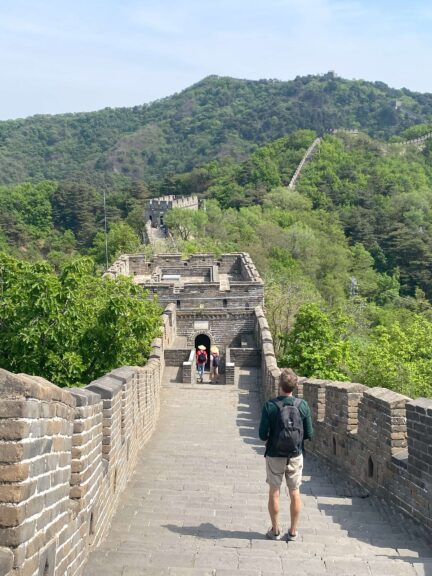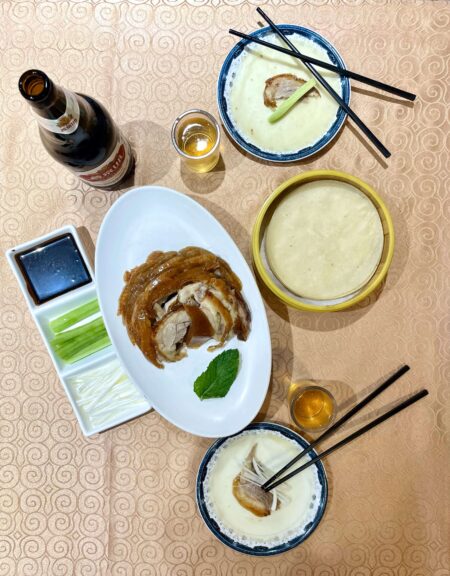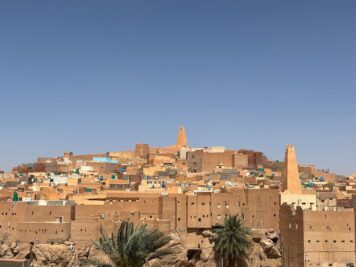This post is about our experience getting a tourist visa for China in Kathmandu, in April 2024.
Most countries require a visa for China but as of quite recently some European passport holders can travel visa free for fifteen days.
We’re overlanding, mostly by public transport, and intended to travel by road from Nepal to China via Tibet. We did a fair bit of research about this visa and how to pick it up on the way. This post is basically my notes on all that pulled together into one place.
So, if you’re in Nepal and thinking about moving on to China, then read on.

Getting the Chinese visa at home or on the road
Before leaving home we knew China was on our route. Ideally we’d have got the Chinese visa in advance at home, and brought it with us. However, Chinese tourist visas usually have a validity window of about three months. In other words, once you have the visa in your passport, you’ve got to enter the country any time in the next three months, and your allotted number of days starts ticking. We’ve been travelling by road and didn’t reach China until about ten months after leaving home, so bringing the visa with us wasn’t an option.
Getting a Chinese visa outside your home country can be a bit of a gamble. But, you can get it at the Chinese Visa Application Service Center in Kathmandu (if they grant it to you, anyway). The center is on the second floor of the Rising Mall in Kathmandu.
Applying for the Chinese visa
Give yourself about a week to get the visa. If you submit all the paperwork on a Monday, and it’s all correct, and they like it, and there are no public holidays that week, you should be able to get the visa by that Friday.
The visa center will keep your passport for the duration. So make sure you’ve got a copy of it if you plan to leave Kathmandu and go for a trek or something while you wait.
You need to fill out the lengthy application form online in advance and print it out. If you make any mistakes, you’ll have to either change it manually and initial the edit, or, depending on the gravity of the mistake, log back in and change it online and print the entire thing out again (true story).
If you can’t find a print shop for some reason, you can print (and photocopy) stuff at the Chinese Visa Application Service Center when you go to apply – for a fairly hefty fee.
When you show up, expect to wait for a while. First, outside for security. Then, inside at a reception desk where they’ll take a quick look at your documents and give you a number. Next, you wait on rows of benches for your number. When it’s your turn they’ll check everything again at the window. If it’s all to their liking your passport and papers disappear into the back, and you get a slip and go to the cashier’s window to pay your fee. The fee depends on things like the length of the visa, and your nationality. Ours were about fifty USD each. They’ll give you a receipt and tell you when to come back to collect.
Come early in the morning to drop off, and in the afternoon to pick up.

Supporting documents
Besides your passport and a signed printout of the completed form, you need a host of other supporting documentation. This does seem to vary a bit from case to case. The very day we were there they stopped asking for passport photos (they just use the photo you upload with your application form).
This is what we had to print and provide:
- a copy of our passports
- proof of funds. We gave a printed screenshot of our bank accounts showing up to three months of transactions. They want to see a couple thousand USD in your balance. OR if you’ve had a visa for China before and can show it (ie it’s in your current passport or you have the previous passport it’s in) then they ask for that, instead of proof of funds.
- return flights in and out of China. Don’t bother mentioning anything about going by road. Just book flights you can cancel, or fake reservations. These are easy to get online for about ten USD.
- hotel bookings for every night we’d be in China. We made reservations on Booking.com all with free cancellation.
- a complete itinerary. This can be handwritten. You need to list up every single day you’ll be in China, where you’ll be, and a few activities you’ll do or sights you’ll see for each and every day.
We paid in cash, Nepalese rupees. They don’t take card.
Regarding the flights, hotel bookings, and itinerary: these don’t need to be your actual plans. Just decide how long you want to spend in China (at the visa center they informed us thirty days was the typical amount they’d grant). Set your entry and exit dates (the flight dates), hotel bookings, and the itinerary according to that. Once you have the visa, you can cancel everything and enter China on any date within the validity period, at any border, and travel as you please for the number of days you’ve got.
Tibet
If you’re planning on going to Xinjiang or Tibet, don’t mention it on your application.
You can’t go to Tibet independently, you have to book a tour.
You can’t get the Chinese visa, then book a Tibet tour and travel by road from Nepal to China (which is what we hoped to do). Going to Tibet requires the ‘Group Visa’ for China. If you’ve already gone to great lengths to get a Chinese visa and then decide to go to Tibet, getting the Group visa voids your regular Chinese visa. If you want to go to Tibet and you’ve got an ordinary Chinese visa, you’d basically need to go into China first by air or by another border (ie just not by road from Nepal) and then you can book a tour to travel into and around Tibet.
If you are determined to go by road from Nepal, then you have to book yourself a tour (they are expensive) and the tour company will arrange the Group visa for you. It requires a minimum of four people and is good for about thirty days including the days spent in Tibet which eats into your time in China. Once you are through Tibet, you are tied to this visa and those two (or more) other people, meaning you have to exit China at the border and date specified on the Group visa, together. This is obviously inconvenient. A couple of the tour operators we talked to mentioned the possibility of paying to ‘split’ the visa up in Lhasa but they didn’t explain how that would work. They also suggested adding two Nepalese passports to a Group visa with the idea being that those two would ‘cancel’ their trip (they’d never actually be on it) and we’d be left on the Group visa ourselves. That seemed a bit complicated – not to mention expensive, as we’d have to pay for the Group visa for four people ourselves, plus the tour.
We dropped Tibet and got the ordinary Chinese tourist visa, and then flew from Kathmandu to Chengdu.
…and other no-nos
I have multiple nationalities. Like on any other visa application, they asked about this. I checked the box ‘Yes’ and listed my nationalities. I was a bit nervous about this because the form states that you should bring any other passports you have, with you when you apply. I don’t have the other passports on me at the moment and they asked about my other nationalities, but they didn’t ask for the passports.
We also had stamps in our passports which China can and does reject applications for: Turkey, Pakistan, Afghanistan, for example. We got our visas successfully but there’s no guarantee. Oddly enough it was when we eventually exited China that we had extra questions and a small holdup due to the Pakistan and Afghanistan stamps.
We applied for a dual/multiple entry visa but were refused and given single entry only. Don’t know why, but possibly it would have been smarter to include (fake) flights to Ulaanbaatar and back in the middle of our itinerary instead of just writing that we would take the train there and come back again later. That being said, there were other things about our application that they initially rejected and told us to ‘fix’. We ran off downstairs to for example, change dates on our itinerary – yet they didn’t suggest booking a flight to UB (or anywhere else) as a means of getting dual entry – they just said dual entry wasn’t possible. They also told us that the maximum amount of time we’d be allowed was thirty days (which worked just fine for us) and so we provided a thirty day itinerary.

Read More
If you’re waiting for your Chinese visa and wondering what to do in the meantime, have a look at this guide to trekking Langtang valley in Nepal.
Or, if you’re in China and ready to leave, read this post about crossing the border from China to Mongolia.



